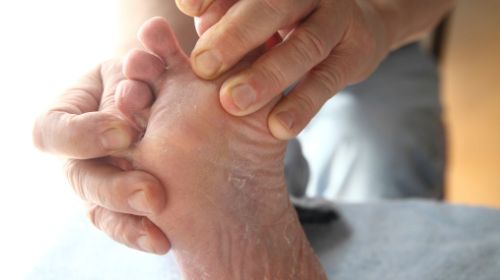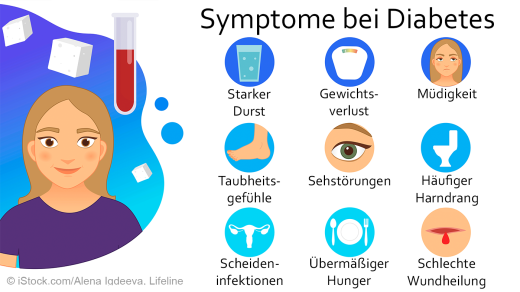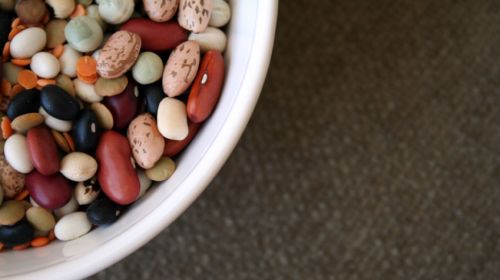An estimated 11 million people in Germany suffer from diabetes mellitus, also known as diabetes. What causes the chronic metabolic disorder and what consequences does the diagnosis have for those affected?
Quick overview: Frequently asked questions and answers
How do I know that I have diabetes? Diabetes can cause frequent urination, persistent thirst, unexplained weight loss, fatigue, and vision problems.
How does diabetes occur? Diabetes occurs when the body is no longer able to properly regulate blood sugar levels, either because the pancreas does not produce enough insulin (type 1 diabetes) or because the body no longer responds properly to insulin (type 2 diabetes ).
Can eating too much sweet give you diabetes? Consuming too much sugar does not automatically cause diabetes. However, a diet high in sugar can lead to overweight and obesity, which significantly increases the risk of type 2 diabetes.
Article contents at a glance:
What is diabetes?
Diabetes mellitus is a metabolic disease, more precisely sugar metabolism. The chronic disease has various causes and is playing an increasingly important role worldwide. In Germany, around nine to ten percent of adults are affected – and the trend is rising.
There are also people with impaired glucose tolerance, which is considered a precursor to diabetes (prediabetes). In addition, it is assumed that the number of unreported cases is high.
What is the difference between type 1 and type 2 diabetes?
There are basically two main forms of diabetes mellitus:
Diabetes type 1: It is an incurable autoimmune disease that usually occurs in childhood or adolescence.
Diabetes type 2: The more common form is usually only diagnosed in old age, which is why it was often referred to as “adult-onset diabetes”. In addition to a hereditary predisposition, an unhealthy lifestyle also promotes the development of the disease.
Other forms of diabetes
There are also rarer special forms that differ significantly in terms of causes and therapies:
Diabetes insipidus: Disturbance of the water-electrolyte balance
LADA (latent autoimmune diabetes in adults): a late-onset type 1 diabetes
MODY (Maturity Onset Diabetes of the Young): adult diabetes that occurs in children and adolescents)
Gestational diabetes (gestational diabetes)
Diabetes mellitus: typical signs
The symptoms of diabetes often develop gradually and can initially go unnoticed. They mainly occur when the sugar level in the blood is extremely high or low. Depending on the type of diabetes, different symptoms are in the foreground.
Symptoms of type 1 diabetes
Typical signs of type 1 diabetes are constant thirst and increased urge to urinate. Significant weight loss can also indicate type 1 diabetes. Other possible symptoms include:
- Tiredness/weakness/listlessness
- severe hunger or loss of appetite
- sudden weight loss
- poorly healing wounds
- increased susceptibility to infections
- Vision problems (“blurred vision”)
If there is severe excess sugar (hyperglycemia), there is also a risk of serious complications, including loss of consciousness (diabetic coma).
Symptoms of type 2 diabetes
In type 2 diabetes, the symptoms are usually less pronounced and less specific. Signs can be:
Causes of diabetes
The body’s cells need glucose (sugar) for energy. Insulin takes on the role of a door opener: the body’s own hormone, which is produced in the pancreas, ensures that glucose gets into the body’s cells.
In diabetes mellitus, this process is disrupted and blood sugar levels rise. Depending on the type of diabetes, this has different causes.
Type 1 diabetes: Absolute insulin deficiency
In type 1 diabetes, there is a dysfunction of the beta cells (islet cells) of the pancreas (islets of Langerhans in the pancreas). As a result, insulin is no longer produced. The form of diabetes is also known as insulin-dependent diabetes.
The cause of the non-functioning beta cells is still not fully known. The fact is that hereditary predisposition plays a role. But environmental factors such as a short period of breastfeeding after birth or viral infections also seem to promote its development.
Type 2 diabetes: Relative insulin deficiency
In type 2 diabetes, the islet cells are initially insulin sensitive. Over time, predominantly insulin resistance occurs, with relative insulin deficiency up to complete insulin resistance.
This means that although the pancreas initially produces enough insulin, the body’s cells become increasingly insensitive to it until they no longer respond to the hormone at all.
The insulin then no longer works sufficiently and does not open the cells properly to absorb sugar. In most cases there is also a genetic predisposition here. However, there are other factors to consider: obesity and lack of exercise are the most important. They are responsible for causing the cell doors to “stick”. More than 90 percent of diabetics suffer from type 2 diabetes.
Examinations and diagnosis of diabetes mellitus
If you suspect diabetes, you should first visit your family doctor. In particular, people who have recently felt unusually thirsty, have to go to the toilet frequently (even at night), feel fatigued and whose family has a history of diabetes should definitely contact a doctor.
After collecting the medical history (anamnesis), doctors will carry out the following examinations:
Diabetes values
The doctor can carry out various examinations if diabetes is suspected. The following values can be abnormal in diabetes:
Fasting blood sugar: If it is repeatedly above 126 mg/dl, you have diabetes. Multiple fasting blood sugar levels between 100 and 125 mg/dl indicate prediabetes. A normal sugar level on an empty stomach is below 125, preferably below 100 mg/dl.
HbA1c value: If the HbA1c value is 6.5 percent or higher, this indicates diabetes. If your HbA1c is between 5.7 and 6.4 percent, you already have prediabetes. Healthy people have an HbA1c value below 5.7 percent.
Oral glucose tolerance test (OGTT): Two hours after ingesting a glucose solution, values above 200 mg/dl (or 11.1 mmol/l) most likely indicate diabetes.
In type 1 diabetes, antibodies against the pancreas or insulin can also be detected in the blood. 90 percent of those who are newly ill carry this.
Treatment of diabetes
In type 1 diabetes, the absolute insulin deficiency must be compensated for. Insulin can be delivered to the body in different ways: by syringe or pump. There are also different types of insulin.
In the case of type 2 diabetes, non-drug measures play an important role in the treatment, and a number of medications are available to regulate blood sugar levels. All treatment measures are intended to prevent serious secondary diseases of nerves, vessels and organs. It is also necessary to monitor blood sugar levels through regular blood sugar measurements.
The most important non-drug measures are:
- right nutrition,
- enough exercise
- Losing excess weight
Medications for diabetes include:
- oral, blood sugar-lowering medications (antidiabetics)
- insulin
Only in a few, advanced cases do people with type 2 diabetes need to inject insulin. Blood sugar levels can usually be easily regulated through a proper diet, sufficient exercise and blood sugar-lowering medication. When the pancreas is relieved, insulin can transport blood into the cells more easily again.
Good to know:
There are now a variety of treatment options that can help you get life with diabetes under control. Modern and easy-to-use blood glucose meters make checking blood sugar levels via blood glucose measurement much easier than it was a few years ago.
Diet for diabetes: What you need to consider
© FUNKE Digital Video
Possible complications of diabetes
If diabetes is poorly controlled, there is a high risk that fine and large blood vessels, nerves and organs such as the kidneys will be damaged by persistently high blood sugar. This is why diabetes can lead to the following secondary diseases:
Due to the possible consequences, feet, eyes, blood pressure and blood lipid levels should be examined regularly. The feet are particularly at risk, as even small wounds can lead to major problems due to delayed wound healing due to poor blood circulation.
Read more about diabetes complications here.
Prognosis and prevention for diabetes
Current research shows that good self-management of chronic illness significantly extends life with diabetes. This applies to both type 1 and type 2 diabetes.
Type 1 diabetes is a chronic disease that cannot be cured. Lifelong insulin supply plays a very important role for those affected. Thanks to today’s treatment options, an almost normal life is possible. The risk of secondary illnesses can be reduced by well-controlled blood sugar.
Type 2 diabetes is also not curable. But it can be easily managed. This includes changing your lifestyle and diet. Losing weight often leads to blood sugar levels returning to normal. This can significantly reduce the risk of secondary illnesses.
As part of a DMP program (Disease Management Program), the doctor checks the blood values and feet regularly so that the therapy can be adjusted at any time. This close care is intended to significantly reduce the risk of the known complications.
Prevention of type 2 diabetes
If there is a genetic predisposition and other risk factors, the onset of type 2 diabetes can be prevented. If blood sugar levels are occasionally elevated, the following measures are recommended, which will prevent the onset of diabetes in most cases:
Weight loss of 5-7 percent within 3 months
At least 2.5 hours of physical activity per week
At least 15 grams of fibrous fiber per 1,000 kilocalories
A maximum of 30 percent fat in the diet
A maximum of 10 percent saturated fatty acids in the diet
In addition, blood sugar should be checked regularly and coordinated with an internist or diabetologist in order to protect blood vessels, nerves and organs.


